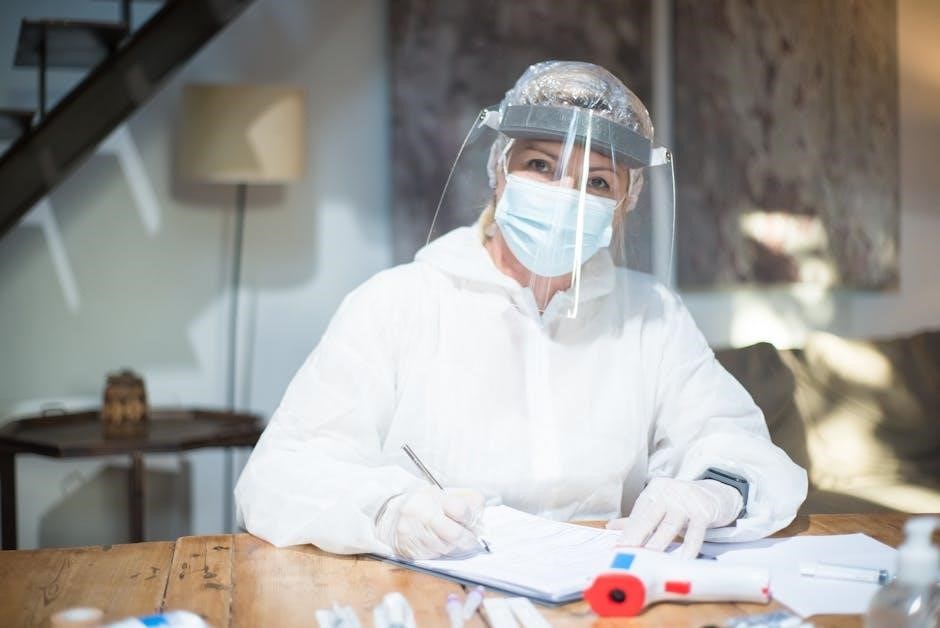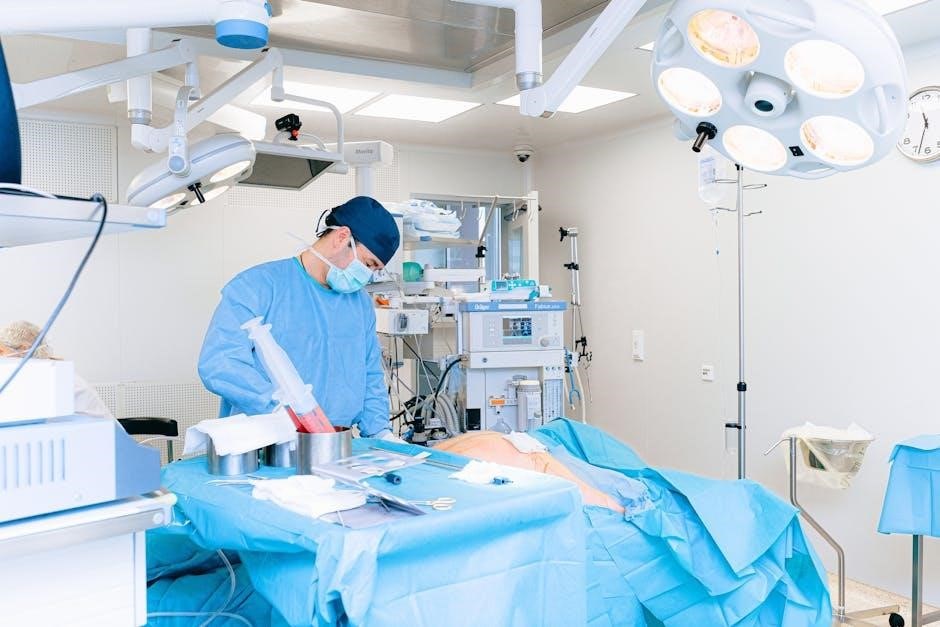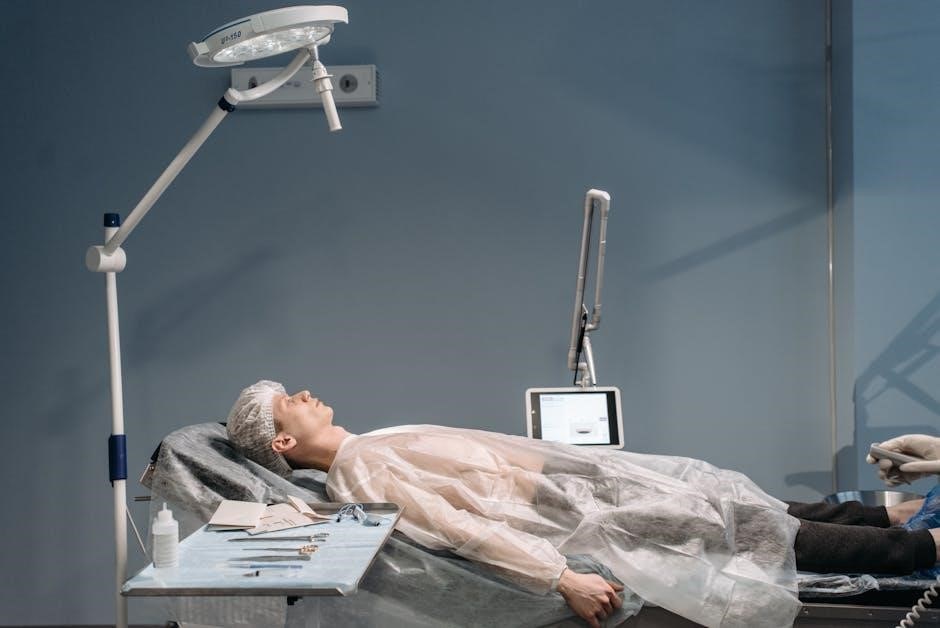Medical-surgical nursing focuses on caring for adult patients with acute or chronic illnesses, emphasizing holistic, patient-centered care. It integrates QSEN competencies, promoting safe, evidence-based practices to manage medical and surgical conditions effectively.
1.1 Definition and Scope
Medical-surgical nursing, also known as adult health nursing, focuses on the care of adult patients with acute or chronic medical or surgical conditions. It encompasses the management of illnesses, injuries, and recovery processes, integrating both medical and surgical interventions. This specialty emphasizes holistic, patient-centered care, addressing physical, emotional, and social needs. The scope includes acute care settings like hospitals and clinics, as well as rehabilitation and community care. Nurses in this field must possess strong assessment, critical thinking, and technical skills to provide evidence-based, high-quality care. It is a foundational area of nursing practice, preparing nurses for various clinical challenges.
1.2 Importance in Healthcare
Medical-surgical nursing plays a vital role in healthcare by providing high-quality, patient-centered care to adults with diverse medical and surgical needs. It bridges the gap between medical and surgical interventions, ensuring seamless care delivery. This specialty emphasizes evidence-based practices, reducing complications and promoting recovery. By addressing acute and chronic conditions, medical-surgical nurses are essential in improving patient outcomes, enhancing safety, and optimizing healthcare resource utilization. Their role is critical in preventing hospital readmissions, managing complex conditions, and supporting patients’ overall well-being, making them indispensable in healthcare systems worldwide.
1.3 Role of Nurses in Medical-Surgical Settings
Nurses in medical-surgical settings are primary caregivers, managing diverse patient needs across the continuum of care. They conduct thorough assessments, develop tailored care plans, and implement evidence-based interventions. Their responsibilities include administering medications, monitoring patient progress, and providing education to patients and families. Nurses also collaborate with interdisciplinary teams to ensure holistic care, focusing on both medical and surgical recovery. Their adaptability, critical thinking, and compassionate approach are crucial in addressing complex, dynamic patient conditions, ensuring optimal outcomes and enhancing patient satisfaction in fast-paced environments.
Key Concepts in Medical-Surgical Nursing
Medical-surgical nursing emphasizes patient-centered care, evidence-based practices, and QSEN competencies, focusing on safety, quality, and interdisciplinary collaboration to address diverse patient needs effectively.
2.1 Patient-Centered Care
Patient-centered care is a cornerstone of medical-surgical nursing, focusing on individualized, respectful, and responsive care tailored to patients’ preferences, values, and needs. This approach ensures active patient involvement in decision-making, enhancing satisfaction and outcomes. Nurses prioritize open communication, empathy, and cultural sensitivity, addressing physical, emotional, and social aspects of care. By integrating patient-centered strategies, nurses foster a supportive environment that promotes healing, dignity, and trust. This care model is integral to improving quality and patient safety, aligning with QSEN competencies.
2.2 Evidence-Based Practice
Evidence-based practice (EBP) in medical-surgical nursing integrates the best available research, clinical expertise, and patient values to guide decision-making. Nurses use current, reliable evidence to develop care plans that improve patient outcomes and safety. EBP promotes the use of proven interventions, reducing variability in care. By staying updated with research and guidelines, nurses ensure high-quality, effective care. This approach fosters a culture of continuous improvement, enhancing patient safety and satisfaction in diverse clinical settings. EBP is a cornerstone of modern nursing practice, aligning with QSEN competencies for safe, effective care delivery.
2.3 QSEN Competencies
QSEN (Quality and Safety Education for Nurses) competencies are essential for medical-surgical nurses, focusing on patient-centered care, teamwork, evidence-based practice, quality improvement, safety, and informatics. These competencies prepare nurses to deliver high-quality, safe care in diverse settings. By integrating QSEN, nurses develop skills to address healthcare challenges, improve patient outcomes, and enhance safety. These competencies are integral to nursing education and practice, ensuring nurses are well-equipped to meet the evolving needs of healthcare systems and provide compassionate, effective care.

Nursing Process in Medical-Surgical Care
The nursing process involves assessment, diagnosis, planning, implementation, and evaluation. It ensures systematic, individualized care, promoting continuity and evidence-based interventions to improve patient outcomes and safety.
3.1 Assessment
Assessment is the first step in the nursing process, involving systematic collection of patient data. It includes physical examinations, interviews, lab tests, and medical history reviews to identify health concerns. Nurses gather information on symptoms, vital signs, and functional status to establish baseline data. This step ensures personalized care plans and informs clinical decisions. Continuous assessment monitors patient progress, detects changes, and guides adjustments in care. Accurate documentation ensures continuity of care and supports effective communication among healthcare providers.
3.2 Diagnosis
Diagnosis in medical-surgical nursing involves identifying actual or potential health problems based on assessment data. Nurses formulate nursing diagnoses (NDs) using standardized taxonomy, such as NANDA-I, to guide care planning. These diagnoses address physical, emotional, or functional issues, like activity intolerance or pain. Accurate diagnosis ensures targeted interventions, improving patient outcomes. Examples include “Impaired mobility” or “Risk for infection.” Nursing diagnoses differ from medical diagnoses, focusing on patient responses to health conditions. They are patient-specific and evidence-based, ensuring individualized care and effective management of medical-surgical conditions.
3.3 Planning
Planning in medical-surgical nursing involves developing individualized care plans based on patient needs and diagnoses. Nurses set realistic, measurable goals aligned with patient outcomes. This phase includes selecting interventions, such as medications, education, or therapies, tailored to each patient’s condition. Evidence-based guidelines and patient preferences guide the plan. Nurses prioritize actions, ensuring a logical sequence of care. Documentation of the plan facilitates communication among healthcare team members. Effective planning promotes efficiency, safety, and achievement of desired patient outcomes, ensuring comprehensive and patient-centered care in medical-surgical settings.
3.4 Implementation
Implementation in medical-surgical nursing involves executing the care plan through direct patient interventions. Nurses administer medications, perform procedures, and provide education tailored to the patient’s needs. This phase requires careful monitoring of patient responses and adherence to evidence-based guidelines. Documentation of actions and outcomes ensures accountability and continuity of care. Effective communication with the healthcare team is critical during implementation to address any concerns or adjustments needed. Nurses prioritize patient safety, comfort, and engagement, making this phase dynamic and patient-centered, focusing on achieving the desired health outcomes.
3.5 Evaluation
Evaluation is the final step in the nursing process, assessing whether patient goals and outcomes have been achieved. Nurses compare the patient’s current health status with the established goals, using assessment data and feedback. This phase involves documenting progress, identifying areas for improvement, and adjusting the care plan as needed. Effective communication with the healthcare team ensures continuity of care. Evaluation also involves patient education and engagement, empowering them to take an active role in their recovery. This step ensures that care is outcomes-driven, patient-centered, and aligned with best practices.

Common Medical-Surgical Conditions
Common conditions include diabetes, hypertension, and acute kidney injury. Nurses manage these by assessing symptoms, implementing evidence-based treatments, and educating patients on prevention and self-care strategies.
4.1 Acute Kidney Injury
Acute kidney injury (AKI) is a sudden loss of kidney function, often caused by ischemia, toxins, or obstruction. Symptoms include decreased urine output, fluid retention, and electrolyte imbalances. Nurses assess for risk factors like dehydration or sepsis. Treatment involves addressing the underlying cause, ensuring adequate hydration, and monitoring renal function. Dialysis may be required in severe cases. Prevention focuses on early detection through regular assessments and managing comorbidities. Nursing care includes patient education on fluid management and medication adherence to prevent progression to chronic kidney disease.
4.2 Benign Prostatic Hyperplasia (BPH)
Benign prostatic hyperplasia (BPH) is a common condition in older men, characterized by an enlarged prostate gland. Symptoms include urinary frequency, hesitancy, weak stream, and nocturia. Causes involve hormonal changes and prostate cell growth. Treatment options include medications like alpha-blockers and 5-alpha reductase inhibitors, or surgery in severe cases. Nursing care focuses on monitoring urinary function, providing comfort, and educating patients on lifestyle modifications, such as avoiding bladder irritants. Early intervention helps improve quality of life and prevent complications like urinary retention or kidney damage.
4.3 Diabetes Mellitus
Diabetes mellitus is a chronic metabolic disorder characterized by elevated blood glucose levels due to impaired insulin secretion or utilization. It is classified into Type 1 (autoimmune, insulin-deficient), Type 2 (insulin-resistant, most common), and gestational diabetes. Symptoms include polyuria, polydipsia, polyphagia, weight loss, and blurred vision. Untreated, it leads to complications like neuropathy, retinopathy, and cardiovascular disease. Management involves insulin therapy, oral hypoglycemics, lifestyle modifications, and monitoring. Nurses play a key role in educating patients on glucose control, diet, and preventing complications through regular screenings and adherence to treatment plans.
4.4 Hypertension
Hypertension, or high blood pressure, is a chronic condition characterized by elevated systolic (≥130 mmHg) and diastolic (≥80 mmHg) readings. It is classified as primary (essential, with no identifiable cause) or secondary (due to underlying conditions like kidney disease or hormonal imbalances); Symptoms may include headache, dizziness, or blurred vision. Untreated, it can lead to cardiovascular complications, such as heart failure or stroke. Management involves lifestyle modifications (e.g., diet, exercise), medications (e.g., ACE inhibitors, diuretics), and regular monitoring. Nurses play a crucial role in educating patients on adherence to treatment and lifestyle changes.
Surgical Nursing Care
Surgical nursing involves preoperative, intraoperative, and postoperative care, focusing on patient preparation, safety during procedures, and recovery. Nurses ensure proper wound care, pain management, and patient education.
5.1 Preoperative Care
Preoperative care ensures patients are physically and psychologically prepared for surgery. Nurses conduct thorough assessments, including medical history, lab tests, and physical exams. Patient education focuses on the procedure, expected outcomes, and postoperative care. Medications are managed, and informed consent is verified. Nurses also ensure proper hygiene, positioning, and equipment preparation. Safety measures, such as verifying patient identity and surgical site, are critical. Effective communication and documentation are essential to ensure a smooth transition to the operating room, minimizing risks and promoting optimal surgical outcomes.
5.2 Intraoperative Care
Intraoperative care focuses on maintaining patient safety and stability during surgery. Nurses monitor vital signs, manage anesthesia effects, and maintain asepsis to prevent infection. They assist surgeons, handle specimens, and ensure accurate documentation. Patient positioning and wound care are prioritized to prevent complications. Effective communication between the surgical team, anesthesiologist, and nurses is crucial. Medications are administered as needed, and equipment is monitored to ensure proper function. The goal is to create a safe, efficient environment that supports optimal surgical outcomes and patient recovery.
5.3 Postoperative Care
Postoperative care focuses on ensuring patient recovery and comfort after surgery. Nurses monitor vital signs, assess surgical sites for bleeding or infection, and manage pain effectively. Oxygen therapy and respiratory support are provided as needed. Patients are positioned to promote healing and prevent complications. Wound care and dressing changes are performed to maintain asepsis. Education on post-discharge care, medication use, and follow-up appointments is essential. The goal is to restore the patient’s physical and emotional well-being, minimizing risks and promoting a smooth transition to recovery.

Nursing Techniques and Procedures
Nursing techniques involve evidence-based practices like wound care, pain management, and IV therapy. Nurses monitor patients, ensure safety, and educate them on recovery procedures, promoting optimal outcomes.
6.1 Wound Care
Wound care involves assessing, cleaning, and dressing wounds to promote healing and prevent infection. Nurses use evidence-based practices, such as debridement and topical treatments, to manage acute or chronic wounds. Proper wound care includes monitoring for signs of infection, like redness or pus, and documenting progress. Patient education on wound management and follow-up care is crucial. Nurses also ensure the use of appropriate dressings and pressure-relieving devices to enhance recovery. Effective wound care is tailored to individual patient needs, adhering to infection control and safety guidelines for optimal outcomes.
6.2 Pain Management
Pain management in medical-surgical nursing involves assessing and treating pain effectively to improve patient outcomes. Nurses use validated pain assessment tools, such as the 0-10 pain scale, to evaluate pain intensity and characteristics. Pharmacological interventions include analgesics, while non-pharmacological methods like relaxation techniques and positioning are also employed. Patient-centered care ensures individualized plans addressing physical and emotional needs. Nurses monitor for adverse effects and adjust therapies as needed. Effective pain management enhances comfort, reduces stress, and promotes recovery, with ongoing documentation ensuring continuity of care.
6.3 IV Therapy
IV therapy involves administering medications, fluids, or nutrients directly into a patient’s bloodstream. Nurses select appropriate venipuncture sites and equipment, ensuring proper insertion and securement of catheters. Monitoring for complications like infiltration, phlebitis, or infection is crucial. Patient education on IV therapy purpose and care is essential. Documentation includes type, rate, and duration of IV therapy, as well as patient responses. Maintaining asepsis and adhering to hospital protocols prevents adverse events, ensuring safe and effective IV therapy administration in various medical-surgical settings.

Medical Management of Diseases
Medical management focuses on pharmacological and non-pharmacological strategies to treat diseases, emphasizing evidence-based practices. It includes symptom relief, disease progression slowing, and patient education for improved health outcomes.
7.1 Pharmacological Interventions
Pharmacological interventions are a cornerstone in managing medical conditions, involving the use of medications to treat, prevent, or alleviate symptoms. Nurses play a vital role in administering drugs, monitoring their effects, and ensuring patient safety. Common drug classifications include analgesics, antibiotics, antihypertensives, and antidiabetics. Personalized treatment plans are developed based on patient needs, medical history, and potential side effects. Nurses educate patients on proper medication use, adherence, and potential interactions. Accurate documentation and continuous monitoring are essential to optimize therapeutic outcomes and minimize adverse reactions, ensuring safe and effective pharmacological care. This approach aligns with evidence-based practices and patient-centered goals.
7.2 Non-Pharmacological Interventions
Non-pharmacological interventions focus on non-drug therapies to manage medical conditions, emphasizing lifestyle modifications, behavioral changes, and alternative therapies. These include dietary adjustments, exercise programs, stress management techniques, and patient education. Nurses play a key role in promoting these interventions, such as encouraging smoking cessation or teaching breathing exercises for chronic obstructive pulmonary disease (COPD). Monitoring vital signs and providing psychological support are also integral. These methods often complement pharmacological treatments, improving patient outcomes and reducing reliance on medications, while enhancing overall well-being and safety.

Prevention and Health Promotion
Prevention and health promotion focus on educating patients to adopt healthy lifestyles, preventing diseases through early detection, and reducing risk factors for chronic conditions, enhancing overall well-being.
8.1 Health Education
Health education empowers patients to make informed decisions about their health. Nurses provide personalized education on disease prevention, healthy lifestyles, and self-care practices. This includes teaching about medication adherence, nutrition, and stress management. By addressing health literacy, nurses help patients understand their conditions and treatment options. Health education also focuses on promoting early detection of diseases and encouraging screenings. Effective education enhances patient outcomes, reduces complications, and fosters a collaborative approach to care, aligning with evidence-based practices and individualized patient needs.
8.2 Disease Prevention Strategies
Disease prevention strategies focus on reducing the risk of developing or managing chronic conditions. Nurses play a key role in implementing primary prevention through vaccinations, health education, and promoting healthy lifestyles. Secondary prevention involves early detection and treatment, such as screenings for cancer or diabetes. Tertiary prevention aims to manage existing conditions, preventing further complications. Nurses also address health literacy and behavioral changes to empower patients. By integrating QSEN competencies, nurses ensure evidence-based, patient-centered care, enhancing overall health outcomes and reducing disease progression.

Specialized Care in Medical-Surgical Nursing
Specialized care focuses on meeting the unique needs of diverse patient populations, including geriatric, oncology, and critical care patients, requiring tailored approaches and advanced nursing skills.
9.1 Geriatric Nursing
Geriatric nursing focuses on providing care to elderly patients, addressing age-related physical and cognitive changes. Nurses manage chronic conditions, promote functional independence, and ensure safe environments. They also implement health education tailored to older adults, emphasizing preventive measures and disease management. Geriatric care requires a holistic approach, considering the patient’s mental, emotional, and social well-being. Nurses must stay updated on best practices to deliver high-quality, patient-centered care to this vulnerable population.
9.2 Oncology Nursing
Oncology nursing involves caring for patients with cancer, focusing on symptom management, treatment administration, and emotional support. Nurses play a key role in administering chemotherapy, managing side effects, and educating patients about their condition; They also provide psychological support to patients and their families. Evidence-based practices are crucial in oncology care to ensure safe and effective treatment. Nurses must stay updated on advancements in cancer therapies and adhere to QSEN competencies, promoting patient-centered care throughout the cancer journey.
9.3 Critical Care Nursing
Critical care nursing involves providing specialized care to patients with life-threatening illnesses or injuries. Nurses in this field manage complex medical conditions, such as multi-organ failure, and operate advanced life-sustaining technologies. They must possess strong assessment skills to identify subtle changes in patient conditions. Critical care nurses prioritize evidence-based interventions, ensuring optimal patient outcomes. Emotional support for patients and families is also a key component of this role. The integration of QSEN competencies ensures safe, patient-centered care in high-acuity settings, making critical care nursing both challenging and rewarding.

Legal and Ethical Considerations
Legal and ethical considerations in nursing involve adherence to patient rights, confidentiality, and informed consent. Nurses must uphold ethical standards and legal obligations to ensure safe, respectful care.
10.1 Patient Rights
Respecting patient rights is fundamental in nursing practice. Patients have the right to autonomy, dignity, and informed consent. Confidentiality must be maintained, and patients should be free from discrimination. Nurses must ensure patients are fully informed about their care, including risks and benefits, enabling them to make decisions. The right to refuse treatment and access to medical records are also essential. Nurses play a key role in advocating for these rights, ensuring ethical and legal standards are upheld in all care settings. These principles ensure safe, respectful, and patient-centered care.
10.2 Confidentiality and Privacy
Confidentiality and privacy are cornerstone principles in healthcare, ensuring patients’ personal and medical information is protected. Nurses must adhere to legal standards like HIPAA to prevent unauthorized disclosure. Privacy involves respecting patients’ personal space and dignity, while confidentiality ensures their information is shared only with authorized individuals. Breaches can erode trust and lead to legal consequences. Nurses must verify identities before sharing information and use secure communication methods. These practices uphold ethical care and patient autonomy, fostering a safe and respectful environment for all individuals. Strict adherence to these principles is essential in building trust between patients and healthcare providers.
10.4 Informed Consent
Informed consent is a critical ethical-legal requirement in healthcare, ensuring patients are fully aware of their treatment options, risks, and benefits. Nurses play a vital role in facilitating this process by providing clear, unbiased information and ensuring patients understand it. Consent must be voluntary, with patients having the capacity to make decisions. Documentation of consent is essential, serving as a legal record of agreement. Nurses must verify comprehension and address any concerns, respecting patients’ autonomy and right to refuse treatment. This process upholds patient-centered care and ethical practice in medical-surgical nursing.

Documentation and Reporting
Documentation involves accurate recording of patient data, serving as a legal and communication tool. It ensures continuity of care and accountability in medical-surgical nursing practice.
11.1 Nursing Notes and Charts
Nursing notes and charts are critical tools for documenting patient care, ensuring clarity and continuity. They record vital signs, treatments, and patient responses, serving as legal records and communication aids. Accurate documentation reflects the quality of care provided, adhering to professional standards. Nurses must ensure entries are concise, objective, and timely, using standardized terminology. These records also facilitate interdisciplinary collaboration and accountability. Proper documentation is essential for legal protection and maintaining patient trust in medical-surgical nursing practice. It ensures seamless care transitions and supports informed decision-making by healthcare teams.
11.2 Effective Communication
Effective communication is vital in medical-surgical nursing, ensuring clear exchange of information between patients, families, and healthcare teams. Nurses must use precise terminology and active listening to convey care plans and patient needs. Verbal and non-verbal cues, such as tone and body language, enhance understanding. Documentation in nursing notes and charts supports continuity of care. Interdisciplinary collaboration relies on clear communication to coordinate treatments and improve patient outcomes. Culturally sensitive communication fosters trust and adherence to care, making it a cornerstone of patient-centered care in medical-surgical nursing practice.

Continuing Education and Professional Development
Continuing education and professional development are essential for medical-surgical nurses to stay updated on evidence-based practices, advanced technologies, and emerging trends, ensuring high-quality patient care and career growth.
12.1 Importance of Lifelong Learning
Lifelong learning is crucial for medical-surgical nurses to maintain competency and adapt to evolving healthcare demands. It ensures they stay updated on best practices, new technologies, and research, ultimately enhancing patient outcomes and professional growth. By committing to continuous education, nurses can address complex clinical challenges effectively, fostering a culture of excellence and safety in their practice. This dedication supports both personal development and the advancement of the nursing profession as a whole.
12.2 Resources for Nursing Education
Various resources support nursing education, including textbooks, handbooks, and online platforms. Textbooks like Brunner and Suddarth’s Medical-Surgical Nursing provide comprehensive guides, while pocket guides offer quick references. Websites such as Nurseslabs and QSEN-based materials ensure evidence-based learning. These tools aid in mastering nursing techniques, understanding disease management, and staying updated on best practices. Accessing these resources helps nurses enhance their skills and deliver high-quality patient care, aligning with professional standards and organizational policies.
